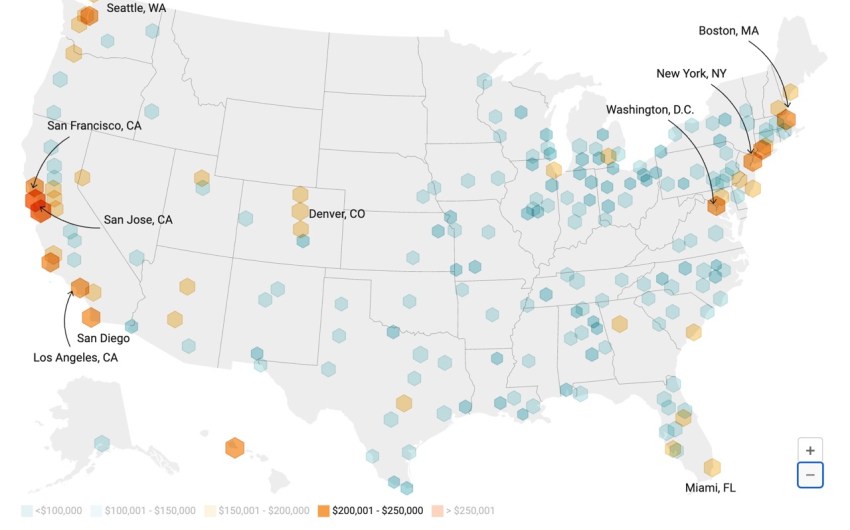How Santa Barbara City Hall Deep-Sixed Its 60-Foot Height Limit
La Cumbre Plaza: Where Good Ideas Don’t Make for Good Deals

EIGHT-AND-A-HALF PERCENT SOLUTION? First rule of journalism: Before you bury the lede, kill it first.
I say this in response to City Hall’s press release issued last week, announcing the first open house and public meet-and-greet to be hosted by Jim and Matthew Taylor, the father-son developer team hoping to build 642 units of rental housing where La Cumbre Plaza now so vacantly stands. By any reckoning, this development is a very big deal. But buried strategically in the middle of this announcement — a concise collision of vanilla and tapioca — was perhaps an even bigger deal: The City Attorney’s Office concluded that the city’s long-sacrosanct — try 51 years — height limit for new developments (60 feet) is now null, void, kaput, finito. Or at least it is at La Cumbre.
The second rule of journalism: Read every page.
For the record, there’s a whole lot to like about this project. It’s a whole lot of desperately needed rental housing units proposed for a really big chunk — 8.7 acres — of essentially dead space that’s undeniably suited to accommodate a whole lot of the aforementioned rental units.
There’s also a lot not to like.
For starters, the developers intend to shred the city’s height limit, building 75 feet up. That’s 15 feet higher than what — until last week’s cunningly oblique press release — we had been assured by the same Powers-That-Be was allowed. In exchange, the developers are proposing to build only 56 units of below-market-rate housing. That number is sufficiently low that the adjective “paltry” must be affixed to it in perpetuity. For the record, that’s roughly 8.5 percent of the units. That’s less than the 10 percent already required by existing city ordinances written — enacted 10 years ago, by the way — to entice, cajole, or otherwise bribe developers to build high-density rental housing in the hope that some of it might actually be affordable.
To quote an unnamed city councilmember not typically inclined to say intemperate things, “It really sucks.”
This is all happening because the State of California — facing a housing affordability crisis of biblical dimensions — has placed a gun to the heads of local government and decreed, “Thou Shall Say Yes to Developers.” I — and a whole lot of others — would suggest the state has been egregiously imprecise in aiming this gun. Simply building more housing should never be confused with building more affordable housing. But try telling that to the State.
I have met with the Taylors a couple of times. We drank coffee and broke bread — okay, it was a muffin. They were easy to hang out with: smart, knew interesting stuff, and quick to laugh. If we’d have played poker, I have little doubt, they’d have walked away with my pink slips.
Perhaps it’s a trivial detail, but I found myself wondering about the name of their chief investor, Mandrake Capital. It’s an investment firm based in New York City that specializes in new housing opportunities. The name “Mandrake” means either “Hand of Glory” or “Brain Thief”; it’s the name of an herbal root known to cause hallucinations, delusions, palpitations, diarrhea, vomiting, and general madness. And, in some cases, death.
With a name like that, clearly, they’re not hiding anything.
Full disclosure: By the time you read this, the Taylors’ open house will have already happened. Barring unforeseen calamity, I will have attended. But that hasn’t happened yet.
When the Taylors first unveiled their plans a year ago, City Hall insisted its 60-foot height limit trumped anything the Taylors wanted to build. The height limit, they pointed out, was chiseled into the city’s charter, which functions as the Magna Carta, 10 Commandments, and Constitution rolled into one. Significantly, this limit was “written” into the charter by a vote of the people — overwhelming, by the way — back in 1972 in response to plans then being fought over whether to erect twin-towered condos 11 stories high in what’s now Alice Keck Park Memorial Garden. In the intervening 51 years, its sway has been absolute.
In other words, it’s a big thing.
The Taylors, likewise, have insisted with formidable stubbornness that a passel of recently passed state laws designed to promote housing development — coupled with one dating back to 1979 — gave them a get-out-of-jail card with respect to the height limit. Because they proposed setting aside 5 percent of the proposed rental units for very-low-income tenants, they argued, state law gave them the right to ignore the height limit.
Buried in the middle of last week’s City Hall press release was verbiage acknowledging that, legally, the Taylors were in the right. City Hall had thrown in the towel on what was a very major sticking point. For the record, the matter was never discussed in any City Council hearing. There had been no public debate, no explanation.
Kind of weird, huh?
Turns out the City Council authorized city staff to consult with outside legal experts who concluded City Hall was holding a losing hand. Given the stiff penalties written into recent law, the city could be on the hook for $3.2 million in penalties, plus attorneys’ fees. To fight and lose, they worried, would not only cost a lot but could set a legal precedent against them with future proposals. And they kept things on the down-low because they didn’t want other developers to see how easy it was.
As if they wouldn’t already know.
Not a good look.
I think lots of housing at La Cumbre makes tons of sense. But only 56 units of affordable housing? “Really sucks” just scratches the surface. Under existing city incentives — again dating back 10 years — the city could extract the same number of below-market units (56) but with 93 fewer total units of housing.
I’m not a developer or an economist. I don’t even play one on TV. But I smell a rotten deal. Or maybe that’s just the mandrake root kicking in.
GET THE MATH RIGHT: It’s come to my attention that I may not know my numerator from my denominator. Or perhaps more to the point, the proper way to calculate bonus density incentives and the right way to figure affordability percentages. In this case, the number of affordable units the developer proposes to build is correct. But for purposes of calculating affordability percentages, the correct number of units to be used is 540 — the amount allowed by the underlying zoning — not 642. Fifty-four of 540 is 10 percent. Not 8.5. I used 642 — the total number of units proposed — to arrive at 8.5 percent. So too did many members of the city council. Either way, it’s a small number of below-market-rate units for a project proposing the bust the height limit by about 15 feet. The point remains. It’s the right site for a lot of rental housing, but not enough affordable units are being proposed to move the needle.
Premier Events
Sat, Apr 27
11:00 AM
Santa Barbara
Santa Barbara Plant Fest
Sat, Apr 27
8:00 PM
Santa Barbara
Beau James Wilding Band Live
Sun, Apr 28
6:00 PM
Santa Barbara
AHA! Presents: Sing It Out!
Thu, May 02
5:00 PM
Santa Barbara
Things with Wings at Art & Soul
Fri, Apr 26
10:00 AM
Santa Barbara
Splendid Plumage Exhibit Opens to Public
Sat, Apr 27
11:00 AM
Santa Barbara
Santa Barbara Plant Fest
Sat, Apr 27
3:30 PM
Santa Barbara
Santa Barbara Trapeze Co and Unity Shoppe Spring Food Drive
Sat, Apr 27
8:00 PM
Santa Barbara
Beau James Wilding Band Live
Sun, Apr 28
11:00 AM
Santa Barbara
Santa Barbara Earth Day Festival 2024
Wed, May 01
7:30 PM
Santa Barbara
American Theatre Guild Presents “Come From Away”
Thu, May 02
5:00 PM
Santa Barbara
100th Birthday Tribute for James Galanos
Thu, May 02
5:00 PM
Santa Barbara
Meet the Creator of The Caregiver Oracle Deck
Fri, May 03
4:00 PM
Santa Barbara
Santa Barbara Fair+Expo “Double Thrill Double Fun”
Fri, May 03
8:00 PM
Santa barbara
Performance by Marca MP
Sat, Apr 27 11:00 AM
Santa Barbara
Santa Barbara Plant Fest
Sat, Apr 27 8:00 PM
Santa Barbara
Beau James Wilding Band Live
Sun, Apr 28 6:00 PM
Santa Barbara
AHA! Presents: Sing It Out!
Thu, May 02 5:00 PM
Santa Barbara
Things with Wings at Art & Soul
Fri, Apr 26 10:00 AM
Santa Barbara
Splendid Plumage Exhibit Opens to Public
Sat, Apr 27 11:00 AM
Santa Barbara
Santa Barbara Plant Fest
Sat, Apr 27 3:30 PM
Santa Barbara
Santa Barbara Trapeze Co and Unity Shoppe Spring Food Drive
Sat, Apr 27 8:00 PM
Santa Barbara
Beau James Wilding Band Live
Sun, Apr 28 11:00 AM
Santa Barbara
Santa Barbara Earth Day Festival 2024
Wed, May 01 7:30 PM
Santa Barbara
American Theatre Guild Presents “Come From Away”
Thu, May 02 5:00 PM
Santa Barbara
100th Birthday Tribute for James Galanos
Thu, May 02 5:00 PM
Santa Barbara
Meet the Creator of The Caregiver Oracle Deck
Fri, May 03 4:00 PM
Santa Barbara
Santa Barbara Fair+Expo “Double Thrill Double Fun”
Fri, May 03 8:00 PM
Santa barbara

























